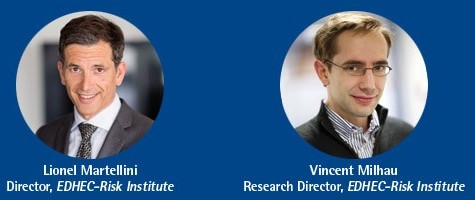
What were EDHEC-risk’s top 10 most read articles of 2019?
Written on 29 Jan 2020.

A Year in Research: focus on sustainable investing, factor investing, machine learning and retirement investing
As we enter a new decade, EDHEC-Risk Institute takes a look back at the most read articles of 2019, covering a diverse range of topics that are at the heart of its expertise.
#1 Sustainable Investing – How Finance Can Help Address the Tragedy of the Horizon
 Dealing with this tragedy of the horizon, and facilitating the transition towards a low-carbon economy, requires a broad array of financial instruments and innovations that will have far-reaching implications for markets, corporations, intermediaries, and investors. Given the widespread recognition of climate change as perhaps the greatest source of long-term risk for asset managers and asset owners, EDHEC-Risk Institute has committed to launching a number of (1) research, (2) outreach and (3) educational initiatives in the area of “Sustainable Investment Solutions”, to help improve our global understanding of climate change finance.
Dealing with this tragedy of the horizon, and facilitating the transition towards a low-carbon economy, requires a broad array of financial instruments and innovations that will have far-reaching implications for markets, corporations, intermediaries, and investors. Given the widespread recognition of climate change as perhaps the greatest source of long-term risk for asset managers and asset owners, EDHEC-Risk Institute has committed to launching a number of (1) research, (2) outreach and (3) educational initiatives in the area of “Sustainable Investment Solutions”, to help improve our global understanding of climate change finance.
#2 EDHEC-Risk on Factor Investing in Sovereign Bond Universes
 The abundance of theoretical and empirical research on factor investing in the equity universe stands in sharp contrast to the relative scarcity of research about how to efficiently harvest risk premia in bond markets. That relatively little is known about the out-of-sample performance of factor-based bond portfolio construction methods is perhaps surprising given the importance of fixed-income investments in institutional and private investors’ portfolios. From the investment practice standpoint, a similar contrast actually exists between factor investing in the equity space, which is a relatively mature subject, and factor investing in bond markets, which still is in its infancy.
The abundance of theoretical and empirical research on factor investing in the equity universe stands in sharp contrast to the relative scarcity of research about how to efficiently harvest risk premia in bond markets. That relatively little is known about the out-of-sample performance of factor-based bond portfolio construction methods is perhaps surprising given the importance of fixed-income investments in institutional and private investors’ portfolios. From the investment practice standpoint, a similar contrast actually exists between factor investing in the equity space, which is a relatively mature subject, and factor investing in bond markets, which still is in its infancy.
#3 Machine Learning for Investment Decisions: A Brief Guided Tour
 Recent developments in data science and machine learning have the potential to improve investment decisions. The fast growth of machine learning algorithms has occurred along with the expanding availability of data at the micro-level. These data hold the key to new breakthroughs. On the other side, there are several challenges to full implementation in investing. One of these is the evolving nature of the investment landscape, where new products and services arise and quickly become widely available and possibly reducing future performance. A potential example is factor investing. Privacy and security are continuing concerns. We review a few curated applications and speculate on the impacts on finance broadly.
Recent developments in data science and machine learning have the potential to improve investment decisions. The fast growth of machine learning algorithms has occurred along with the expanding availability of data at the micro-level. These data hold the key to new breakthroughs. On the other side, there are several challenges to full implementation in investing. One of these is the evolving nature of the investment landscape, where new products and services arise and quickly become widely available and possibly reducing future performance. A potential example is factor investing. Privacy and security are continuing concerns. We review a few curated applications and speculate on the impacts on finance broadly.
#4 Taxonomy of Sustainable Investing – An Investment Process Perspective
We strongly believe that creating a common language for all actors in the financial system will be helpful in promoting private sector’s contribution to long-term sustainable growth. This paper is an attempt to contribute to this effort by providing clarification and taxonomy with a focus on an investment process perspective. Similar to common practice in investment management, the paper initiates the discussion on the commitment to earning social and environmental returns by drawing on the key distinction between objectives and constraints. The paper then divides into two main sections to discuss the selection process and the allocation process. We hope our paper will provide useful clarification to asset managers and asset owners seeking to promote sustainable investing practices.
#5 EDHEC-Risk is launching the world's first online finance course on machine learning applied to investment management
 In this interview, Caroline Prévost discusses the newly launched specialization Investment Management with Python and Machine Learning. She explains why EDHEC-Risk decided to partner with Coursera to develop this online programme and why they chose to explore asset management through the prism of machine learning. She provides further details of the 4 MOOCs delivered and tells us how these online courses fit into ERI's Executive Education offering.
In this interview, Caroline Prévost discusses the newly launched specialization Investment Management with Python and Machine Learning. She explains why EDHEC-Risk decided to partner with Coursera to develop this online programme and why they chose to explore asset management through the prism of machine learning. She provides further details of the 4 MOOCs delivered and tells us how these online courses fit into ERI's Executive Education offering.
#6 Insights from the 12th EDHEC European ETF, Smart Beta and Factor Investing Survey
 EDHEC-Risk Institute conducted its 12th survey as part of the Amundi “ETF, Indexing and Smart Beta Investment Strategies” research chair at EDHEC-Risk Institute. The aim of this study is to analyse current European investor practices and perceptions with respect to ETFs, smart beta and factor investing strategies, as well as future plans in these domains. By comparing our results to those of our previous surveys, over more than a decade, we aim to shed light on trends within the ETF market and within the smart beta and factor investing strategy offer.
EDHEC-Risk Institute conducted its 12th survey as part of the Amundi “ETF, Indexing and Smart Beta Investment Strategies” research chair at EDHEC-Risk Institute. The aim of this study is to analyse current European investor practices and perceptions with respect to ETFs, smart beta and factor investing strategies, as well as future plans in these domains. By comparing our results to those of our previous surveys, over more than a decade, we aim to shed light on trends within the ETF market and within the smart beta and factor investing strategy offer.
#7 Paper co-authored by Lionel Martellini and Vincent Milhau wins the 20th Annual Bernstein Fabozzi/Jacobs Levy Award for Outstanding Article from the Journal of Portfolio Management

The paper, entitled "Proverbial Baskets Are Uncorrelated Risk Factors! A Factor-Based Framework for Measuring and Managing Diversification in Multi-Asset Investment Solutions", which was co-authored by Lionel Martellini, Professor of Finance, EDHEC Business School and Director of EDHEC-Risk Institute, together with Vincent Milhau, Research Director at EDHEC-Risk Institute, was originally published in the Multi-Asset Special Issue 2018 of The Journal of Portfolio Management. Multi-asset investment solutions have become increasingly popular among sophisticated institutional investors focusing on efficient harvesting of risk premia across and within asset classes. One key challenge in the construction of diversified multi-asset portfolio strategies is that even a seemingly well-balanced allocation to many asset classes can eventually translate into a portfolio with a very concentrated set of underlying risk exposures. The authors suggest using a factor-based framework to more effectively measure and manage diversification in multi-asset portfolios.
#8 Factor Investing in Sovereign Bond Markets: A Time-Series Perspective
In this first paper, authors provide a positive answer to this question with respect to time-series factors such as the level of interest rates and, albeit to a lesser extent, the slope of the yield curve. More precisely, they first confirm (using both yield curve and CUSIP-level data in the US) the well-known finding that long-term bonds do appear to offer a higher unconditional excess return over shortterm rates, an excess return which is also known as the bond risk premium. They also confirm that the magnitude of the excess return generated by such an unconditional carry strategy is relatively small (much smaller than the equity risk premium) and has been negative for extended periods. As a matter of fact, the risk premium associated with an unconditional exposure to the slope factor (via flattener or steepener strategies) is even smaller, if not zero).
#9 Factor-Based Commodity Investing
 Commodities represent a small but significant part of alternative assets in institutional investor portfolios. Commodity investors stress the low correlation between commodities and traditional investments (like equities and bonds) as well as the diversification benefits of including commodities in portfolios. They also view commodities as one of the few assets offering protection against rising inflation. The fall in commodity prices since the financial crisis of 2008 and the sharp fall of S&P GSCI, the benchmark used by most institutional investors to evaluate commodity investments, raised questions about the long-term return potential of commodities and the role of commodities in strategic asset allocation.
Commodities represent a small but significant part of alternative assets in institutional investor portfolios. Commodity investors stress the low correlation between commodities and traditional investments (like equities and bonds) as well as the diversification benefits of including commodities in portfolios. They also view commodities as one of the few assets offering protection against rising inflation. The fall in commodity prices since the financial crisis of 2008 and the sharp fall of S&P GSCI, the benchmark used by most institutional investors to evaluate commodity investments, raised questions about the long-term return potential of commodities and the role of commodities in strategic asset allocation.
#10 Monetary Easing at a Crossroads - Comments on FOMC & FED's meeting
 Riccardo Rebonato, Professor of Finance, EDHEC-Risk Institute, EDHEC Business School is specialist in interest rate risk modelling with applications to bond portfolio management and fixed-income derivatives pricing. He comments on June FOMC & FED's meeting. The equity markets heaved a sigh of relief after Chairman Powell’s words at the post-FOMC meeting conference, interpreting his remarks as an implicit assurance that (if needed) the policy of the Greenspan / Bernanke / Yellen ‘put’ will be continued under his stewardship. Matters are not quite as straightforward, however, for two important reasons.
Riccardo Rebonato, Professor of Finance, EDHEC-Risk Institute, EDHEC Business School is specialist in interest rate risk modelling with applications to bond portfolio management and fixed-income derivatives pricing. He comments on June FOMC & FED's meeting. The equity markets heaved a sigh of relief after Chairman Powell’s words at the post-FOMC meeting conference, interpreting his remarks as an implicit assurance that (if needed) the policy of the Greenspan / Bernanke / Yellen ‘put’ will be continued under his stewardship. Matters are not quite as straightforward, however, for two important reasons.
Stay tuned on our website to be informed on EDHEC-Risk future events or on events involving EDHEC-Risk participation:
- Open enrolment: Investment Management with Python and Machine Learning Specialisation (4 MOOCs)
- 26 May 2020 (Paris): Beyond Beta Annual Conference "Defining and Understanding the Smart Beta, Factor Investing and ESG Investment Revolution", hosted by ETF Stream
- June 23-24-25, 2020 (London): The Advances in Asset and Factor Allocation Seminar: Factor Investing, Goal-Based Investing and Sustainable Investing
- 16 September 2020 (London): Big Call: Fixed Income ETFs, hosted by ETF Stream
- TBC: 2nd edition of the EDHEC Climate Finance Conference

